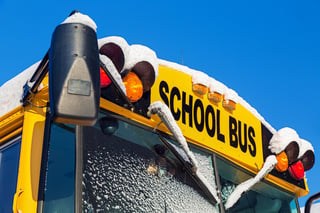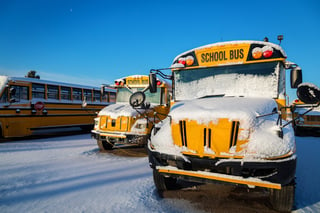 School buses carry precious cargo. So when it comes to school bus safety, drivers should receive extensive training about arrival and departure procedures, emergency protocols, and the importance of pre-trip inspection checklists.
School buses carry precious cargo. So when it comes to school bus safety, drivers should receive extensive training about arrival and departure procedures, emergency protocols, and the importance of pre-trip inspection checklists.
School bus safety starts before your engine does
When most people hear the phrase school bus safety, they think about things like seat belts and defensive driving. However, when it comes to your buses, safety starts before your yellow-and-black fleet leaves the lot.
The first step to protect your students and drivers is to run through a pre-trip checklist:
- Windshield wipers: In addition to checking wiper fluid levels, be sure to check wiper blades. In the event of heavy rain, sleet, or snow, damaged wipers (or a dry fluid reservoir), can become an issue for even veteran bus drivers.
- Lights: Check to ensure all interior and exterior lights are functioning properly — not just headlights. You should check emergency lights, flashing stop lights, rear lights, and fog lights, before every trip.
- Emergency equipment: Hopefully, you never have to use your onboard emergency equipment. However, if an incident arises, the equipment must be in proper working condition. Inspect triangle kits, stretchers, fire blankets, fire extinguishers, first aid kits, seat belt cutters, and any other emergency equipment onboard prior to leaving the lot each morning.
- Brakes: Buses require ample room and fully functioning brakes to come to a complete stop. If your brake pads are worn, immediately seek replacement parts.
- Bus shocks: In addition to providing a smooth ride, shocks help keep a bus safely on the road. Malfunctioning shocks may cause a bus to swerve or even roll over.

- Security cameras: Security cameras are an integral aspect of school bus safety. There is no point in having a camera onboard your bus if it is not working properly. The presence of a camera is a good deterrent to rowdy behavior, and can record instances of misconduct.
- Wheelchair securement points: In order to transport special needs students, your bus must have a 7-point securement system — 4 points for the student’s wheelchair and 3 for the student.
- Tires: Your shocks and tires work in tandem to keep your buses grounded. Balding or damaged tires can cause poor traction.
School bus safety tips for boarding and deboarding students
 A school bus driver’s job is over only when every student is safely dropped off and the bus is back in the lot. In many cases, the most unpredictable part of a student’s journey is when he or she is being picked up or dropped off. While your drivers may be well-trained in pickup/drop-off protocol, you should stress the importance of awareness training.
A school bus driver’s job is over only when every student is safely dropped off and the bus is back in the lot. In many cases, the most unpredictable part of a student’s journey is when he or she is being picked up or dropped off. While your drivers may be well-trained in pickup/drop-off protocol, you should stress the importance of awareness training.
After boarding or deboarding students, drivers should take a moment to look around and listen for any warning that a child or pedestrian may be near the bus. Noisy equipment should be silenced, and rowdy students should be reminded to keep calm.
Instruct students to look for a signal from the bus driver in order to know when it's safe to cross the street, or get on or off the bus. It is also important for students to put away cell phones and earbuds at this time.
Emergency training for bus drivers
Bus drivers must have proper training for adverse weather conditions and emergency situations. Every driver in your school bus fleet should know how to react to road hazards — including ice, flooding, snow, fog, rain, construction, and potholes. And emergencies can be anything from the bus breaking down, to a student having an allergic reaction. A driver who is well-trained in school bus safety knows how to quickly respond in any emergency situation.




